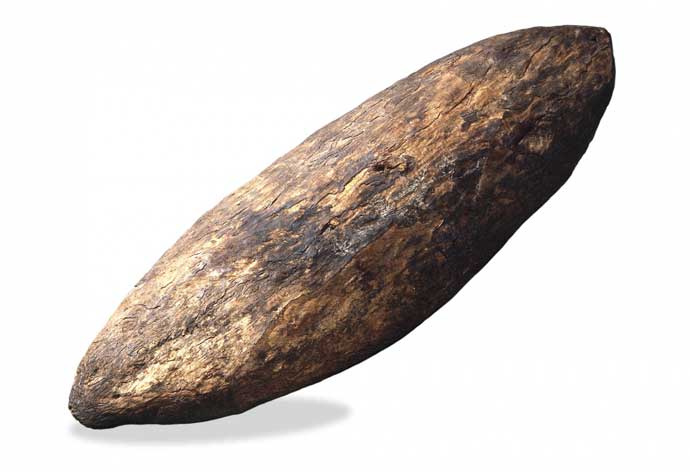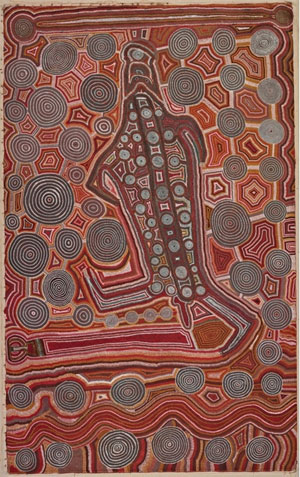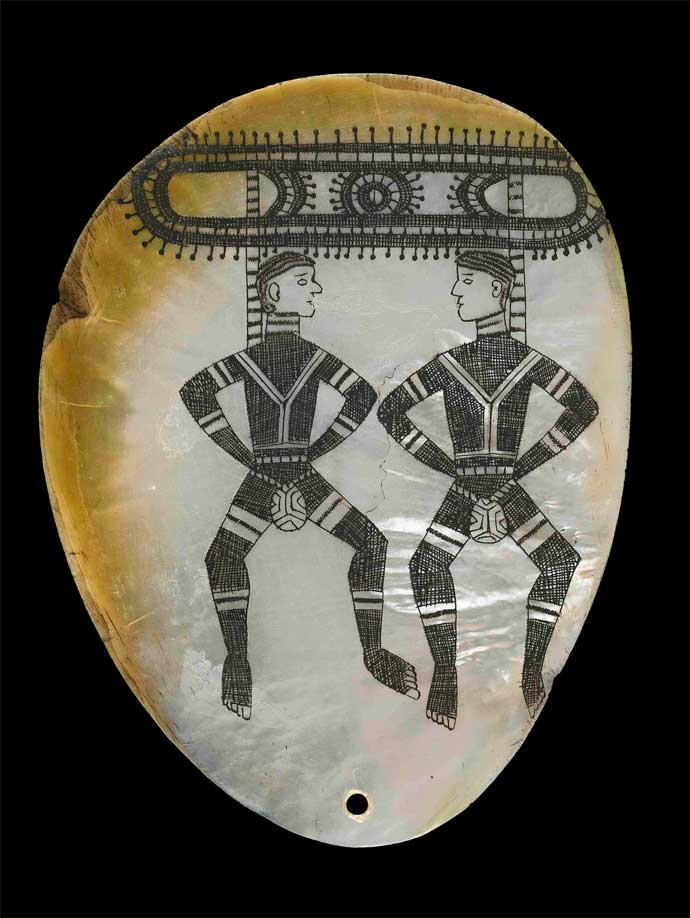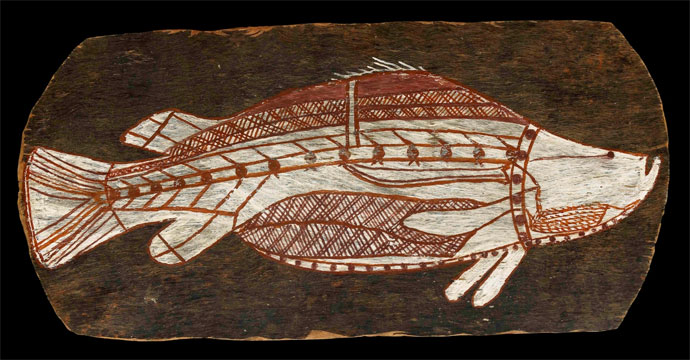Preservation or respect, The battle over the British Museum's First Nation Australian show
Should First Nations culture be preserved primarily in institutions, as too many paternal white politicians insist? Or is it best lived and nurtured in traditional lifestyles in home countries across the continent?
It's been less than a century since the world's leading collectors began acknowledging First Nations art as more than mere ethnographic artefact.
Since then, the most enlightened, from Hong Kong to London, New York to Paris, have understood that when you purchase a piece of First Nations art you become its custodian - not its owner.

Shield collected at Botany Bay during Captain Cook's visit, 1770
First Nations people are calling for the objects on show at the British Museum's new exhibition to be returned. Can colonial artefacts ever escape their violent past?
Paul Daley The Guardian 9 April

It's been less than a century since the world's leading collectors began acknowledging Indigenous Australian art as more than mere ethnographic artefact. Since then, the most enlightened, from Hong Kong to London, New York to Paris, have understood that when you purchase a piece of Indigenous art you become its custodian - not its owner. That image depicting a moment on one of the myriad songlines that have criss-crossed the continent during 60,000 years of Indigenous civilisation can adorn your wall. But you will never have copyright. Sometimes, not even the creator owns the painterly iconography and motif attached to particular stories that are family, clan or tribe - but not individual - possessions.
Such understanding is now implicit in the compact between collectors and creators, as remote Indigenous Australian arts centres match a rapacious international market with the rights of some of the world's most accomplished, and impoverished, modern artists to support themselves and their families. But for museums, especially those of the great empires, ownership of Indigenous cultural property remains an existential bedrock. Which brings me to the British Museum and its forthcoming exhibition, Indigenous Australia: Enduring Civilisation. To call this exhibition - and a related one, Encounters, planned for Canberra's National Museum of Australia - controversial dramatically understates the bitter politics, anger and behind-the-scenes enmity provoked by the British Museum's continued ownership of some 6,000 Indigenous Australian items variously acquired after British contact, invasion and occupation of the continent beginning in 1770.
Some Indigenous Australians want what they rightly regard as their property (some of it stolen in circumstances of extreme violence on the Australian colonial frontier) returned. Others have been more conciliatory, saying that the British Museum (which insists it has been on a long journey of consultation with Indigenous communities ahead of its exhibition) has preserved items that would otherwise have been lost.

Yumari, Uta Uta Tjangala, 1981
Indigenous Australian activists are, sources say, likely to mount some form of protest when the exhibition opens in London. Much bigger, angrier, protests and possible legal action are likely to greet the Canberra exhibition in November when items from the British Museum collection will go to Australia under the safeguard of the 2013 Protection of Cultural Objects on Loan Act which legally prohibits Indigenous moves for repatriation.
Forewarning of this comes from Shane Mortimer, an elder of the Ngambri people on whose land the Australian capital, Canberra, is built: "If the Ngambri people went to England, killed 90% of the population and everything else that is indigenous to England and sent the crown jewels back to Ngambri Country as a prize exhibit … what would the remaining 10% of English people have to say about that? The exhibition should not proceed without the permission of the owners of all of the items." And that will never be granted.
After the British Museum launched its exhibition in January, veteran Indigenous Australian activist Gary Foley wrote on the museum's Facebook page: "Bet they won't be prepared to seriously discuss issues of repatriation of cultural materials obtained through nefarious means ... because of their retention of the so-called ‘Elgin marbles'." Last month, historian and university lecturer Foley again attacked the museum in a seminar convened by the Greek Orthodox community of Melbourne, which sees parallels between the museum's stance on the requested return of Indigenous Australian objects and the Parthenon marbles. He said: "The British Museum grew out of the era of colonialism. The rest of the world grew out of those ideas 100 years ago. Their position has no credibility in the modern world. It's really that simple."

Pearl-shell pendant with dancing figures, pre-1926. Facebook Twitter Pinterest
Repealing the Australian legislation that will protect Indigenous objects on loan to Australia from the British Museum collection would "highlight the outrageous position of those at the British Museum who refuse to return anything to anybody, because they're scared of the precedent that might be, in terms of the Parthenon Marbles," Foley said.
The British Museum holds more than 6,000 Indigenous Australian items in its collection, of which only a minute percentage is usually on display. With the addition of some items from Australian collections including the national museum, it is in a unique position to tell a compelling story of one of the oldest, most resilient civilisations over 60 millennia, including its relatively recent, catastrophic, point of contact with colonialism. Exhibition objects include stone and metal tools, ceremonial headdresses, baskets, spears, masks, fish traps, photographs, and paintings, some of which have never been displayed before. The older objects have profound spiritual significance for the communities where they belong, linking the living with ancestors and elements of the past.
They also testify to the existential threat that was implied in first contact. Perhaps most seminal is the wooden shield dropped by a Gweagel tribesman during a violent confrontation with the crew of Captain James Cook's HMB Endeavour at Botany Bay in autumn 1770. Witness, botanist Joseph Banks, insisted that the obvious hole in the shield came from a "single pointed lance"; Indigenous Australians say the hole is from a musket round - more plausible, you'd have to agree, given Cook and his men shot at and wounded Gweagel that day.
An elegant exhibition catalogue does not attempt to sugar-coat the violence against and dispossession of the locals, who died in vast numbers (estimates vary from a conservative 20,000 to at least 60,000) in clashes with explorers, settlers, British soldiers and police until the last accepted massacre at Coniston, Northern Territory, in 1928. "The essential truth is that Aboriginal people were dispossessed from their land by force, their populations reduced by disease and violence, and their cultural beliefs and practices disrespected and sometimes destroyed." Indeed, the catalogue - which includes essays by Gaye Sculthorpe, the Indigenous Tasmanian curating the exhibition who has, since 2013, been curator of the museum's Oceania and Australia section - is perhaps indispensible when it comes to understanding the back story of this contentious collection.
Sculthorpe's involvement has been controversial for some Indigenous people agitating for the repatriation of items in the British Museum's collection. Some are furious. Others see a potential advantage in having Sculthorpe - one of Australia's most esteemed curators of Indigenous Australian cultural material - on the inside. Gary Murray, an elder of the Dja Dja Wurrung people of central Victoria, who knows Sculthorpe well, says: "We actually hope that Gaye Sculthorpe stays there at the British Museum because she is our link to that Indigenous collection that they stubbornly refuse to give back to us. She is a good mediator - we know that from her involvement in native title disputes in Australia." (Sculthorpe was a member of the National Native Title Tribunal which helps determine Indigenous land claims under the Australian Commonwealth Native Title Act for 13 years until 2013). "But me and my people believe she needs to step up right now and show strong leadership and get our things back - not stand in front of the display case. We're waiting."

Bark painting of a barramundi, c.1961 Facebook Twitter Pinterest
The catalogue includes the oldest- known pieces of rare bark art created by the Dja Dja Wurrung that were sold to the museum in the 1850s by Scottish settler John Hunter Kerr. Murray was central to a failed Dja Dja Wurrung attempt to have the barks permanently returned to his people while they were on loan from the British Museum to the Melbourne Museum in 2004. Murray, supported by many others including Foley - who then worked at the Melbourne Museum (where Sculthorpe, too, had once worked) - invoked the Federal Aboriginal Cultural Heritage Act to seize the barks while they were in Victoria. After a protracted court case brought by the Melbourne Museum (now Victoria Museum) that was fought largely at the behest of the British Museum (not least, to guarantee future loans), the barks were returned to London.
At least one of the barks is likely to visit its country of origin again for the linked Canberra exhibition later this year, shielded by the 2013 Protection of Cultural Objects on Loan Act. While that legislation covers objects on loan from all countries, it was intentionally drafted to prevent the repatriation of Indigenous artefacts on loan to Australia. Most of the thousands of ancestral human remains in collections across Europe and elsewhere are not covered by the act; intransigence by institutions such as the British Museum, however, constitute the biggest continued impediment to the repatriation of Indigenous Australian body parts.
Of the Dja Dja Wurrung barks, Murray told me recently: "It taunts us spiritually."
Why?
"Because it's our inheritance. They belong to my people. And they have been denied to us. They are a direct link to our ancestors. They are for me and for my children and my grandchildren. And I'm not going to be around for long, so we want them back."
The inclusion of the barks in the exhibition catalogue, when their permanent repatriation is off the table, is provocative, even if it references their contentious backstory: "This particular case, and others like it, touches on a number of the fraught and challenging issues with which the Indigenous Australia: Enduring Civilisation exhibition engages." The British Museum, it says, grapples with issues "involved in ensuring that connections between people and collections are maintained … This exhibition is just one small part of this very complex and ongoing process".
Indeed, the questions that burn uncomfortably at the core of this exhibition and the linked one in Canberra are about imperial acquisition and continued ownership. The counter-argument, of course, has always been that had the British Museum not acquired items such as the Dja Dja Wurrung barks and the Gweagel shield, they may otherwise have turned to dust. Is salvation - or imperial arrogance - most identifiable in the British Museum's Indigenous collection? Many of the items in this collection were, after all, designed for utilitarian, ceremonial or decorative function - not posterity.
Which leads to bigger questions: should Indigenous Australian culture be preserved primarily in institutions, as too many paternal white politicians insist? Or is it best lived and nurtured in traditional lifestyles in home countries across the continent?
• Indigenous Australians: Enduring Civilisation is at the British Museum, London WC1, 23 April-2 August. Details: britishmuseum.org

